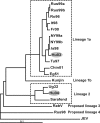Lineage 1 and 2 strains of encephalitic West Nile virus, central Europe
- PMID: 16704810
- PMCID: PMC3294705
- DOI: 10.3201/eid1204.051379
Lineage 1 and 2 strains of encephalitic West Nile virus, central Europe
Abstract
Two different West Nile virus (WNV) strains caused lethal encephalitis in a flock of geese and a goshawk in southeastern Hungary in 2003 and 2004, respectively. During the outbreak in geese, 14 confirmed human cases of WNV encephalitis and meningitis were reported in the same area. Sequencing of complete genomes of both WNV strains and phylogenetic analyses showed that the goose-derived strain exhibits closest genetic relationship to strains isolated in 1998 in Israel and to the strain that emerged in 1999 in the United States. WNV derived from the goshawk showed the highest identity to WNV strains of lineage 2 isolated in central Africa. The same strain reemerged in 2005 in the same location, which suggests that the virus may have overwintered in Europe. The emergence of an exotic WNV strain in Hungary emphasizes the role of migrating birds in introducing new viruses to Europe.
Figures

References
-
- Smithburn KC, Hughes TP, Burke AW, Paul JH. A neurotropic virus isolated from the blood of a native of Uganda. Am J Trop Med Hyg. 1940;20:471.
-
- Peiris JSM, Amerasinghe FP. West Nile fever. In: Beran GW, Steele JH, editors. Handbook of zoonoses. Section B: Viral. 2nd ed. Boca Raton (FL): CRC Press; 1994. p. 139–48.
Publication types
MeSH terms
LinkOut - more resources
Full Text Sources
Other Literature Sources
Medical
